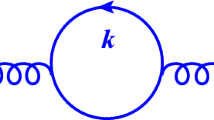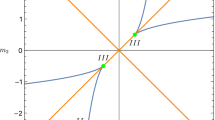Abstract
Strong-weak coupling duality in string theory allows us to compute physical quantities both at the weak coupling end and at the strong coupling end. Furthermore perturbative string theory can be used to compute corrections to the leading order formula at both ends. We explore the possibility of constructing a smooth interpolating formula that agrees with the perturbation expansion at both ends and leads to a fairly accurate determination of the quantity in consideration over the entire range of the coupling constant. We apply this to study the mass of the stable non-BPS state in SO(32) heterotic / type I string theory with encouraging results. In particular our result suggests that after taking into account one loop corrections to the mass in the heterotic and type I string theory, the interpolating function determines the mass within 10% accuracy over the entire range of coupling constant.
Similar content being viewed by others
References
E. Witten, Superstring perturbation theory revisited, arXiv:1209.5461 [INSPIRE].
M.B. Green, S.D. Miller, J.G. Russo and P. Vanhove, Eisenstein series for higher-rank groups and string theory amplitudes, Commun. Num. Theor. Phys. 4 (2010) 551 [arXiv:1004.0163] [INSPIRE].
V. Asnin et al., High and low dimensions in the black hole negative mode, Class. Quant. Grav. 24 (2007) 5527 [arXiv:0706.1555] [INSPIRE].
D.J. Gross, J.A. Harvey, E.J. Martinec and R. Rohm, The heterotic string, Phys. Rev. Lett. 54 (1985) 502 [INSPIRE].
D.J. Gross, J.A. Harvey, E.J. Martinec and R. Rohm, Heterotic string theory. 1. The free heterotic string, Nucl. Phys. B 256 (1985) 253 [INSPIRE].
D.J. Gross, J.A. Harvey, E.J. Martinec and R. Rohm, Heterotic string theory. 2. The interacting heterotic string, Nucl. Phys. B 267 (1986) 75 [INSPIRE].
A. Sen, SO(32) spinors of type-I and other solitons on brane-anti-brane pair, JHEP 09 (1998) 023 [hep-th/9808141] [INSPIRE].
A. Sen, Type I D particle and its interactions, JHEP 10 (1998) 021 [hep-th/9809111] [INSPIRE].
A. Sen, Stable nonBPS states in string theory, JHEP 06 (1998) 007 [hep-th/9803194] [INSPIRE].
A. Sen, Stable nonBPS bound states of BPS D-branes, JHEP 08 (1998) 010 [hep-th/9805019] [INSPIRE].
O. Bergman and M.R. Gaberdiel, Stable nonBPS D particles, Phys. Lett. B 441 (1998) 133 [hep-th/9806155] [INSPIRE].
E. Witten, D-branes and k-theory, JHEP 12 (1998) 019 [hep-th/9810188] [INSPIRE].
J. Polchinski and E. Witten, Evidence for heterotic-type-I string duality, Nucl. Phys. B 460 (1996) 525 [hep-th/9510169] [INSPIRE].
J. Polchinski, Dirichlet branes and Ramond-Ramond charges, Phys. Rev. Lett. 75 (1995) 4724 [hep-th/9510017] [INSPIRE].
J. Polchinski, S. Chaudhuri and C.V. Johnson, Notes on D-branes, hep-th/9602052 [INSPIRE].
E. Witten, String theory dynamics in various dimensions, Nucl. Phys. B 443 (1995) 85 [hep-th/9503124] [INSPIRE].
M. Frau, L. Gallot, A. Lerda and P. Strigazzi, Stable nonBPS D-branes in type-I string theory, Nucl. Phys. B 564 (2000) 60 [hep-th/9903123] [INSPIRE].
M. Frau, L. Gallot, A. Lerda and P. Strigazzi, Stable nonBPS D-branes of type-I, hep-th/0003022 [INSPIRE].
M. Frau, L. Gallot, A. Lerda and P. Strigazzi, D-branes in type-I string theory, Fortsch. Phys. 49 (2001) 503 [hep-th/0012167] [INSPIRE].
D. Friedan, E.J. Martinec and S.H. Shenker, Conformal invariance, supersymmetry and string theory, Nucl. Phys. B 271 (1986) 93 [INSPIRE].
J.J. Atick and A. Sen, Correlation functions of spin operators on a torus, Nucl. Phys. B 286 (1987) 189 [INSPIRE].
H. Kleinert and V. Schulte-Frohlinde, Critical properties of ϕ 4 -theories, World Scientific, River Edge U.S.A. (2001), pg. 489.
Author information
Authors and Affiliations
Corresponding author
Additional information
ArXiv ePrint: 1304.0458
Rights and permissions
About this article
Cite this article
Sen, A. S-duality improved superstring perturbation theory. J. High Energ. Phys. 2013, 29 (2013). https://doi.org/10.1007/JHEP11(2013)029
Received:
Accepted:
Published:
DOI: https://doi.org/10.1007/JHEP11(2013)029




